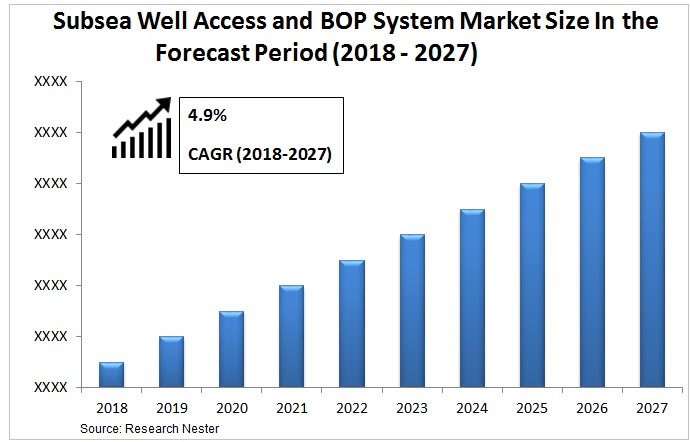Subsea Well Access and BOP System Market Trends
Growth Drivers
- Requirement of Clean Energy - Contrary to fossil fuel sources, green energy comes from sustainable resources. This signifies that their supplies are endless and cannot be consumed. This sector is a main driver for the economy and is expected to increase substantially. Electricity networks are another major propelling force. They account for 70% of recent mineral requirements from the energy technologies taken into account in this study, although their share remains to fall as other technologies – most particularly EVs and storage – register quick expansion.
- Emerging Advancements in Technologies and IoTs -The service sector has been working on modifying the latest technologies and business plans to increase and modify well control and wellbore unification. Much of the importance has been on creating an offshore blowout preventer (BOP) system, and multiple technologies have been invented to match the ever-rising needs and challenges brought about by ultra-deepwater, and high-pressure/high-temperature reservoirs. Moreover, a typical subsea deepwater blowout preventer control system (BOP) comprises agents like electrical and hydraulic lines, control pods, hydraulic authorities, test valves, kill and choke lines and valves, riser joint, hydraulic linkers, and a support frame.
- Increasing Recovery of Hydrocarbon Liquids- Conventional and unconventional hydrocarbons are liable to stay the primary agent of the energy mix required to match the increasing global energy demand in the next 50 years. The lifecycle of an oilfield is primarily attributed to three basic stages: production buildup, plateau production, and reducing production. Maintaining the needed production levels throughout the lifecycle needs a good comprehension of and the potential to control the recovery mechanisms included. For primary recovery (i.e., natural depletion of reservoir pressure), the lifecycle is generally short and the recovery factor does not surpass 20% in most scenarios. For secondary recovery, depending on either natural or artificial water or gas injection, the gradual recovery ranges from 15 to 25%. Internationally, the total recovery factors for mixed primary and secondary recovery range between 35 and 45%.
Challenges
- The Drop in Crude Oil Production - The global production of crude oil could decrease by approximately 40 million B/D by 2020 from existing projects, and an extra 25 million B/D of oil will be required to be generated for the supply to keep pace with intake. Scientific discoveries and technological creations are required, not only to protect the supply of reasonable hydrocarbons but also to limit the environmental influence of hydrocarbon recovery and use. While the members of the OPEC usually determine the supply, the U.S. has been the latest contributor to deciding oil prices with its exports from oil shales. To illustrate, the oil prices in 2014 took a huge drop after both OPEC and the US wore out so much oil, which surpassed the international consumption threshold. In crises like wars and geopolitical fluctuation, the balance between demand and supply tolerates and destabilizes international oil prices. Because of a range of political reasons, oil supplies could be stayed or diminished by some oil-generating countries.
- Strict Environmental Rules
- Shortage of Skilled Technicians
Subsea Well Access and Blowout Preventer System Market: Key Insights
The Global Subsea Well Access and BOP System market is expected to reach around USD 13 billion in 2027 at a CAGR of 4.9 %.till the period of 2018-2027.On the basis of regional platform, Global Subsea Well Access and BOP System market is segmented into five major regions including North America, Europe, Asia Pacific, Latin America and Middle East & Africa region.
North America is expected to hold the largest share in Global Subsea Well Access and BOP System Market till the expected forecast period i.e. 2018-2027. Additionally, increased drilling and exploration activities in Canada is adding to significant growth rate of Subsea Well Access and BOP System market. Moreover, development of new fields and shale gas extraction at offshore is also expected to propel the growth of market at a significant rate. Furthermore, new innovations in R&D technology for enhanced oil recovery is vigorously propelling the growth of market in forecasted period.
Asia pacific region is also slated for steady growth rate in Subsea Well Access and BOP System Market backed by approval from government to drill and explore about 132 blocks in China. Additionally, production of methane gas in India and Australia is also expected to escalate the market growth till forecast period of 2018-2027.
Get more information on this report: Download Sample PDF
|
Base Year |
2024 |
|
Forecast Year |
2025-2037 |
|
CAGR |
∼4.1% |
|
Base Year Market Size (2024) |
USD 3.12 billion |
|
Forecast Year Market Size (2037) |
USD 5.26 billion |
|
Regional Scope |
|

